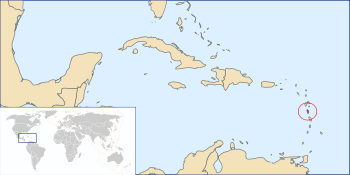Dominica
The Commonwealth of Dominica is an island nation in the Caribbean Sea. It is an English-speaking country.[4] It is between the French-speaking territories of Guadeloupe and Martinique. The island is 751 km² (290 mi²) in area. Roseau is its capital. Portsmouth is another main town. Almost 70,000 people live on the island.
Commonwealth of Dominica | |
|---|---|
| Motto: | |
| Anthem: | |
 | |
| Capital and largest city | Roseau 15°18′N 61°23′W / 15.300°N 61.383°W |
| Official languages | English |
| Ethnic groups (2001) | Black 86.8% Mixed 8.9% Carib Amerindian 2.9% White 0.8% Other 0.7%[1] |
| Demonym(s) | Dominican |
| Government | Parliamentary republic |
| Sylvanie Burton[2] | |
| Roosevelt Skerrit | |
| Independence | |
• from the United Kingdom | 3 November 1978 |
| Area | |
• Total | Lua error in Module:Convert at line 1850: attempt to index local 'en_value' (a nil value). (184th) |
• Water (%) | 1.6 |
| Population | |
• July 2009 estimate | 72,660 (195th) |
• 2011 census | 71,293 |
• Density | Lua error in Module:Convert at line 1850: attempt to index local 'en_value' (a nil value). (95th) |
| GDP (PPP) | 2011 estimate |
• Total | $977 million[3] |
• Per capita | $13,815[3] |
| GDP (nominal) | 2011 estimate |
• Total | $489 million[3] |
• Per capita | $6,909[3] |
| HDI (2007) | high · 73rd |
| Currency | East Caribbean dollar (XCD) |
| Time zone | UTC–4 (Eastern Caribbean) |
| Driving side | left |
| Calling code | +1-767 |
| ISO 3166 code | DM |
| Internet TLD | .dm |
| |
The currency of the island is the East Caribbean dollar.
The island's name comes from the Latin for Sunday, Dies Dominica. It is not the Spanish-speaking Dominican Republic in the Greater Antilles.
The country is nicknamed the Nature Island of the Caribbean.
Dominica is most famously depicted in Jean Rhys' classic prequel to Jane Eyre, Wide Sargasso Sea.
History
The indigenous Carib people lived in Dominca before it was found by Europeans. They called it Wai‘tu kubuli, which means "Tall is her body."
Christopher Columbus came to Dominica in 1493. In 1763, it became a territory of the United Kingdom from which its independence was received on 3 November 1978.
In August 1979, Hurricane David, wiped out its entire infrastructure. On 21 November 2004, the island was hit by its most destructive earthquake in history; Portsmouth and the northern area were deeply affected.
On 18 September 2018, Hurricane Maria, the most powerful storm to hit the island, severely damaged its infrastructure and cut off all its communications to the outside world. The Assessment Capacities Project estimates that the hurricane has caused $1.37 billion in losses across the island, which is equal to 226 percent of its 2016 GDP. As of April 12, there are 65 fatalities confirmed across the island, including 34 who are missing and presumed to be dead.[5]
In 1980, Dame Eugenia Charles became its prime minister, the first female government leader in the West Indies.
Geography
Dominica is an island nation in the Caribbean Sea. It is the northernmost of the Windward Islands.
Dominica is largely covered by rainforest. It is home to the world's second-largest hot spring, Boiling Lake.[6]
Morne Trois Pitons National Park is a tropical forest with scenic volcanic features. It was recognised as a World Heritage Site on 4 April 1995.[7]
Administrative divisions
Dominica is divided into 10 parishes, given below with their 2011 Census populations:
- Saint Andrew Parish (9,471)
- Saint David Parish (6,043)
- Saint George Parish (21,241)
- Saint John Parish (6,561)
- Saint Joseph Parish (5,637)
- Saint Luke Parish (1,668)
- Saint Mark Parish (1,834)
- Saint Patrick Parish (7,622)
- Saint Paul Parish (9,786)
- Saint Peter Parish (1,430)
Sports
Cricket is a popular sport on the island. Dominica competes in test cricket as part of the West Indies cricket team.
Netball, basketball, rugby, tennis and association football are gaining popularity as well.
Gallery
Dominica Media
National Anthem of Dominica: Isle of Beauty, Isle of Splendour
Dominica stamps with portraits of King George VI and Queen Elizabeth II
Eugenia Charles, Prime Minister 1980–95, discussing the situation in Grenada in 1983 with US President Ronald Reagan
Damage in Roseau caused by Hurricane Maria in 2017
Dominica is an island in the Eastern Caribbean Sea, with the French Republic to the north (as Guadeloupe), and to the south (as Martinique).
Related pages
References
- ↑ "Dominica Ethnic groups 2001 Census". Archived from the original on 2016-01-30. Retrieved 2012-05-25.
- ↑ "Office of the President". Government of the Commonwealth of Dominica. Retrieved 17 December 2016.
- ↑ 3.0 3.1 3.2 3.3 "Dominica". International Monetary Fund. Retrieved 2012-04-18.
- ↑ The Commonwealth Website
- ↑ "Hurricane Maria". Wikipedia. 2018-11-03.
- ↑ "Disaster Officials Issue Warning as Things Cool Down At Dominica's Boiling Lake". Caribbean 360. November 22, 2016. Archived from the original on 27 November 2016. Retrieved 17 December 2016.
- ↑ "Morne Trois Pitons National Park by World Heritage Sites". Whc.unesco.org. Retrieved 16 December 2016.
Other websites
- Dominica in the News Archived 2021-07-04 at the Wayback Machine
- SaKaFete Archived 2005-08-19 at the Wayback Machine
- Official Tourism Website Archived 2018-09-14 at the Wayback Machine
- World Creole Music Festival Archived 2017-09-18 at the Wayback Machine
- Media related to Dominica at Wikimedia Commons
